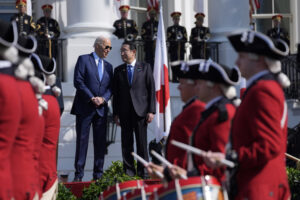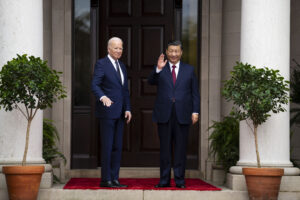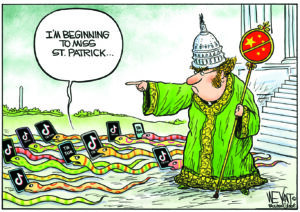How Donald Trump’s Trade Wars Could Lead to a Great Depression
If you make enemies out of your friends and friends out of your enemies, where does that leave you? 16:9clue / CC BY 2.0
16:9clue / CC BY 2.0
Leaders are routinely confronted with philosophical dilemmas. Here’s a classic one for our Trumptopian times: If you make enemies out of your friends and friends out of your enemies, where does that leave you?
What does winning (or losing) really look like? Is a world in which walls of every sort encircle America’s borders a goal worth seeking? And what would be left in a future fragmented international economic system marked by tit-for-tat tariffs, travel restrictions, and hyper-nationalism? Ultimately, how will such a world affect regular people?
Let’s cut through all of this for the moment and ask one crucial question about our present cult-of-personality era in American politics: Other than accumulating more wealth and influence for himself, his children, and the Trump family empire, what’s Donald J. Trump’s end game as president? If his goal is to keep this country from being, as he likes to complain, “the world’s piggy bank,” then his words, threats, and actions are concerning. However bombastic and disdainful of a history he appears to know little about, he is already making the world a less stable, less affordable, and more fear-driven place. In the end, it’s even possible that, despite the upbeat economic news of the moment, he could almost singlehandedly smash that piggy bank himself, as he has many of his own business ventures.
Still, give him credit for one thing: Donald Trump has lent remarkable new meaning to the old phrase “the imperial presidency.” The members of his administration, largely a set of aging white men, either conform to his erratic wishes or get fired. In other words, he’s running domestic politics in much the same fashion as he oversaw the boardroom on his reality TV show The Apprentice.
Now, he’s begun running the country’s foreign policy in the same personalized, take-no-prisoners, you’re-fired style. From the moment he hit the Oval Office, he’s made it clear at home and abroad that it’s his way or the highway. If only, of course, it really was that simple. What he will learn, if “learning process” and “President Trump” can even occupy the same sentence, is that “firing” Canada, the European Union (EU), or for that matter China has a cost.
What the American working and the middle classes will see (sooner than anyone imagines) is that actions of his sort have unexpected global consequences. They could cost the U.S. and the rest of the world big time. If he were indeed emperor and his subjects (that would be us) grasped where his policies might be leading, they would be preparing a revolt. In the end, they — again, that’s us — will be the ones paying the price in this global chess match.
The Art of Trump’s Deals
So far, President Trump has only taken America out of trade deals or threatened to do so if other countries don’t behave in a way that satisfies him. On his third day in the White House, he honored his campaign promise to remove the U.S. from the Trans Pacific Partnership, a decision that opened space for our allies and competitors, China in particular, to negotiate deals without us. Since that grand exit, there has, in fact, been a boom in side deals involving China and other Pacific rim countries that has weakened, not strengthened, Washington’s global bargaining position. Meanwhile, closer to home, the Trump administration has engaged in a barrage of NAFTA-baiting that is isolating us from our regional partners, Canada and Mexico.
Conversely, the art-of-the-deal aficionado has yet to sign a single new bilateral trade deal. Despite steadfast claims that he would serve up the best deals ever, we have been left with little so far but various tariffs and an onslaught against American trading partners. His one claim to bilateral-trade-deal fame was the renegotiation of a six-year-old deal with South Korea in March that doubled the number of cars each U.S. manufacturer could export to South Korea (without having to pass as many safety standards).
As White House Press Secretary Sarah Sanders put it, when speaking of Kim Jong Un’s North Korea, “The President is, I think, the ultimate negotiator and dealmaker when it comes to any type of conversation…” She left out the obvious footnote, however: any type that doesn’t involve international trade.
In the past four months, Trump has imposed tariffs, exempting certain countries, only to re-impose them at his whim. If trust were a coveted commodity, when it came to the present White House, it would nowbe trading at zero. His supporters undoubtedly see this approach as the fulfillment of his many campaign promises and part of his classic method of keeping both friends and enemies guessing until he’s ready to go in for the kill. At the heart of this approach, however, lies a certain global madness, for he now is sparking a set of trade wars that could, in the end, cost millions of American jobs.
The Allies
On May 31st, Commerce Secretary Wilbur Ross confirmed that Canada, Mexico, and the EU would all be hit with 10% aluminum and 25% steel tariffs that had first made headlines in March. When it came to those two products, at least, the new tariffs bore no relation to the previous average 3% tariff on U.S.-EU traded goods.
In that way, Trump’s tariffs, initially supposed to be aimed at China (a country whose president he’s praised to the skies and whose trade policies he’s lashed out at endlessly), went global. And not surprisingly, America’s closest allies weren’t taking his maneuver lightly. As the verbal abuse level rose and what looked like a possible race to the bottom of international etiquette intensified, they threatened to strike back.
In June, President Trump ordered that a promised 25% tariff on $50 billionworth of imported goods from China also be imposed. In response, the Chinese, like the Europeans, the Canadians, and the Mexicans, immediately promised a massive response in kind. Trump countered by threatening another $200 billion in tariffs against China. In the meantime, the White House is targetting its initial moves largely against products related to that country’s “Made in China 2025” initiative, the Chinese government’s strategic plan aimed at making it a major competitor in advanced industries and manufacturing.
Meanwhile, Mexico began adopting retaliatory tariffs on American imports. Although it has a far smaller economy than the U.S., it’s still the second largest importer of U.S. products, buying a whopping $277 billion of them last year. Only Canada buys more. In a mood of defiance stoked by the president’s hostility to its people, Mexico executed its own trade gambit, imposing $3 billion in 15%-25% tariffs against U.S. exports, including pork, apples, potatoes, bourbon, and cheese.
While those Mexican revenge tariffs still remain limited, covering just 1% of all exports from north of the border, they do target particular industries hard, especially ones that seem connected to President Trump’s voting “base.” Mexico, for instance, is by far the largest buyer of U.S. pork exports, 25% of which were sold there last year. What its 20% tariff on pork means, then, is that many U.S. producers will now find themselves unable to compete in the Mexican market. Other countries may follow suit. The result: a possible loss of up to 110,000 jobs in the pork industry.
Our second North American Free Trade Agreement (NAFTA) partner (for whose prime minister, Justin Trudeau, there is “a special place in hell,” according to a key Trumpian trade negotiator) plans to invoke tariffs of up to 25% on about $13 billion in U.S. products beginning on July 1st. Items impacted range “from ballpoint pens and dishwasher detergent to toilet paper and playing cards… sailboats, washing machines, dish washers, and lawn mowers.”Across the Atlantic, the EU has similarly announced retaliatory tariffs of 25% on 200 U.S. products, including such American-made classics as Harley-Davidson motorcycles, blue jeans, and bourbon.
Trump Disses the Former G7
As the explosive Group of Seven, or G7, summit in Quebec showed, the Trump administration is increasingly isolating itself from its allies in palpable ways and, in the process, significantly impairing the country’s negotiating power. If you combine the economies of what might now be thought of as the G6 and add in the rest of the EU, its economic power is collectively larger than that of the United States. Under the circumstances, even a small diversion of trade thanks to Trump-induced tariff wars could have costly consequences.
 President Trump did try one “all-in” poker move at that summit. With his game-face on, he first suggested the possibility of wiping out all tariffs and trade restrictions between the U.S. and the rest of the G7, a bluff met with a healthy dose of skepticism. Before he left for his meeting with North Korean leader Kim Jong Un in Singapore, he even suggested that the G7 leaders “consider removing every single tariff or trade barrier on American goods.” In return, he claimed he would do the same “for products from their countries.” As it turned out, however, that wasn’t actually a venture into economic diplomacy, just the carrot before the stick, and even it was tied to lingering threats of severe penalties.
President Trump did try one “all-in” poker move at that summit. With his game-face on, he first suggested the possibility of wiping out all tariffs and trade restrictions between the U.S. and the rest of the G7, a bluff met with a healthy dose of skepticism. Before he left for his meeting with North Korean leader Kim Jong Un in Singapore, he even suggested that the G7 leaders “consider removing every single tariff or trade barrier on American goods.” In return, he claimed he would do the same “for products from their countries.” As it turned out, however, that wasn’t actually a venture into economic diplomacy, just the carrot before the stick, and even it was tied to lingering threats of severe penalties.
The current incipient trade war was actually launched by the Trump administration in March in the name of American “national security.” What should have been highlighted, however, was the possible “national insecurity” in which it placed the country’s (and the world’s) future. After all, a similar isolationist stance in the 1920s and the subsequent market crash of 1929 sparked the global Great Depression, opening the way for the utter devastation of World War II.
European Union countries were incredulous when Trump insisted, as he had many times before, that the “U.S. is a victim of unfair trade practices,” citing the country’s trade deficits, especially with Germany and China. At the G7 summit, European leaders did their best to explain to him that his country isn’t actually being treated unfairly. As French President Emmanuel Macron explained, “France runs trade deficits with Germany and the United Kingdom on manufactured goods, even though all three countries are part of the EU single market and have zero tariffs between them.”
Having agreed to sign on to a post-summit joint statement, the president suddenly opted out while on his flight to Singapore, leaving his allies in the lurch (and subsequently slamming the Canadian prime minister as “very dishonest” and “weak”). In that communiqué, signed by the other six summit attendees, they noted, “We strive to reduce tariff barriers, non-tariff barriers, and subsidies… We acknowledge that free, fair and mutually beneficial trade and investment, while creating reciprocal benefits, are key engines for growth and job creation.”
The Pushback
The fallout domestically from the coming trade wars could be horrific if Trump truly makes good on his promises and refuses to back down, while the countries he’s attacking ratchet up their own responses, whether in terms of tariffs or simply a refusal to buy American goods. According to the U.S. Chamber of Commerce, up to 2.6 million American jobs could be threatened if, in the process, the U.S. also withdraws from NAFTA.
Even American CEOs are now running scared of the CEO-in-chief. A recent survey conducted by the Business Roundtable lobby group, chaired by JPMorgan Chase CEO Jamie Dimon, revealed that their “economic outlook index” had declined this past quarter from a record high, the first drop in two years. According to the report, nearly two-thirds of the CEOs surveyed considered trade policy a “serious risk.” Rather than planning future corporate hiring sprees, as Trump might have us believe, their fears of future trade wars actually seem to be curtailing job-expansion plans.
European leaders at the G7 summit admitted that, despite their own role in escalating global trade tensions, the coming wars “would hurt everyone.” And therein lies the danger and the disconnect. Thanks largely to Donald Trump, the leaders of the key countries on the planet could now proceed to destroy trade relationships, knowing full well that the results will hurt their workers and damage the global economy.
A recent report by Andy Stoeckel and Warwick McKibbin for the Brookings Institution analyzed just such a future trade war scenario and found that, if global tariffs were to rise just 10%, the gross national product (GDP) of most countries would fall by between 1% and 4.5% — the U.S. GDP by 1.3%, China’s by 4.3%. A 40% rise in tariffs would ensure a deep global recession or depression. In the 1930s, it was the punitive U.S. Smoot-Hawley tariff that helped spark the devastating cocktail of nationalism and economic collapse that culminated in World War II. This time, who knows what The Donald’s tariffs will spark?
The End Game
When trade wars escalate and geopolitical tensions rise, economies can be badly damaged, leading to a vicious cycle of aggressive responses. And here’s the remarkable thing about the power of America’s imperial presidency in 2018: Donald Trump could unilaterally slow, alter, or under certain circumstances even shut down various elements of global trade — and if he manages to do so, there will be a price to pay in jobs and in this planet’s economic stability.
Catalyzed by tweets, denunciations, insults, and the tariff-first shots of his administration, our allies will undoubtedly try to trade more with each other to close gaps that his trade wars open. Ultimately, that will hurt the U.S. and its workers, especially Trump’s base. For instance, German carmaker BMW, Japanese carmaker Toyota, and other foreign car companies employ 130,000 people in the United States. If, in response to new tariffs on their products, they were to begin moving their operations to France or Mexico in retaliation, it’s American workers who would lose out.
But make no mistake: American allies, who rely on the staggeringly powerful U.S. market, will lose out, too. Weighed down by tariffs, their products will become less competitive here, which is what Trump wants. However, that won’t necessarily mean the end of trade deficits; it could just mean less trade everywhere, a situation that should bring to mind the global depression of the 1930s. And if you think Donald Trump is already a threat to world stability, imagine what might happen after years of economic duress. As was the case in the 1930s, when volatile conditions made it easier for dictators like Adolf Hitler to convince people that their economic woes stemmed from others, the path to a fire-and-fury world remains grimly open.
In Washington, Donald Trump’s unique version of the imperial presidency seems to be expanding to fill any void as alliances like the G7 that were once so crucial to the way the United States dominated much of the planet and its economy are being diminished. The question that should make anybody nervous is not yet answerable: What’s the end game?
The global economic system first put in place after World War II was no longer working particularly well even before President Trump’s trade wars began. The problem now is that its flaws are being exacerbated. Once it becomes too expensive for certain companies to continue operating as their profits go to tariffs or tariffs deflect their customers elsewhere (or nowhere), one thing is certain: it will get worse.
Your support matters…Independent journalism is under threat and overshadowed by heavily funded mainstream media.
You can help level the playing field. Become a member.
Your tax-deductible contribution keeps us digging beneath the headlines to give you thought-provoking, investigative reporting and analysis that unearths what's really happening- without compromise.
Give today to support our courageous, independent journalists.






You need to be a supporter to comment.
There are currently no responses to this article.
Be the first to respond.